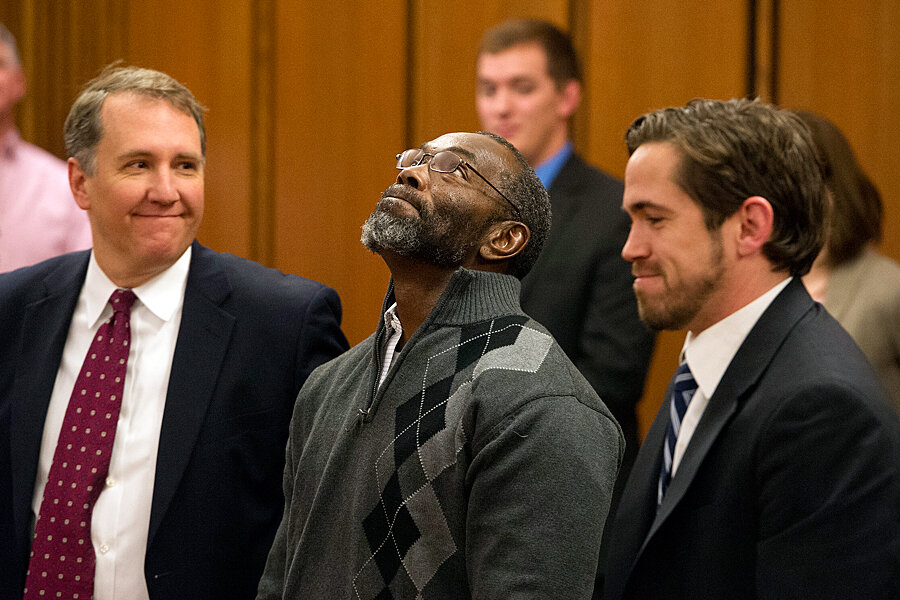Two Ohio men freed 39 years after wrongful conviction. What changed?
Loading...
Two Ohio men have been released from prison after spending 39 years behind bars.
Ricky Jackson and brothers Wiley and Ronnie Bridgeman were sentenced to death for the 1975 robbery and shooting death of Harold Franks, a money-order salesman from the Cleveland area. The sentences, which were later commuted to life imprisonment, hinged mainly on the testimony of Eddie Vernon, who was 13 at the time he testified. However, Mr. Vernon gave inconsistent testimony, providing different locations for where he said he saw the attack.
Exposing these inconsistencies was a 2011 article published in Cleveland Scene magazine titled "What the Boy Saw." It also highlighted the lack of evidence linking Mr. Jackson and the Bridgeman brothers to the crime, none of whom had had a criminal record prior to being convicted, according to the National Registry of Exonerations at the University of Michigan Law School.
Ronnie Bridgeman, who is now known as Kwame Ajamu, was released from prison in 2003. But Jackson and Wiley Bridgeman – who got parole briefly in 2002 before being sent back to prison – remained incarcerated until the Ohio Innocence Project took up the case.
When the pair were freed Friday, the Ohio Innocence Project said Jackson was the longest-serving US prisoner to be exonerated, NBC News reported.
Innocence Project cases are known for hinging on DNA evidence, but the Ohio Innocence Project took up this case even though no such evidence existed.
The re-investigation into the case revealed that Vernon had tried to take back his identification of the three defendants at the time, but had been coerced into testifying by the police. Moreover, police reports at the time note that law enforcement had considered two other men as suspects, but stopped investigating them once Vernon identified the Bridgemans and Jackson, according to the National Registry of Exonerations.
But this month, at a hearing on a motion by Jackson for a new trial, Vernon set the record straight.
"I don't have any knowledge about what happened at the scene of the crime," he testified. "Everything was a lie. They were all lies."
Because no DNA or physical evidence was used in the exoneration, much of the work came from finding people who knew what happened and were willing to share their side of the story.
In a two-day evidentiary hearing, all the witnesses corroborated Vernon's testimony – that he was on a school bus at the time the crime occurred. He was not close enough to accurately see what took place, according to Brian Howe, an attorney with the Ohio Innocence Project, who represented Jackson.
"At the end of those two days, the evidence was overwhelming," he said in an interview with the Monitor, noting the importance of finding people who could speak to what transpired all those years ago. "We were finding new witnesses two weeks before the [hearing]. There was so much hard work that culminated today in Mr. Jackson walking out a free man. It's an incredible thing."
Kyle Swenson, the former staff writer for Cleveland Scene who penned the 2011 article, was also convinced of their innocence.
"I absolutely believed they were wrongfully convicted," he told Cleveland's Fox 8 News. "I worked on this story for six months. Just going through old court documents, contacting people from their neighborhood where they all grew up, I was absolutely convinced they were wrongfully convicted."
The main factor that contributed to the three men's convictions – perjury or false accusation – is considered the primary reason for false convictions, according to the National Registry of Exonerations. Fifty-six percent of false convictions stem from this factor, it says.
The registry, which dates back to 1989, indicates that 2013 was a record year for exonerations, with 91. In total since 1989, 1,465 exonerees have been documented.
In 2014 so far, there have been 87 exonerations, which includes those for Jackson and Wiley Bridgeman.
• Material from the Associated Press was used in this report.








